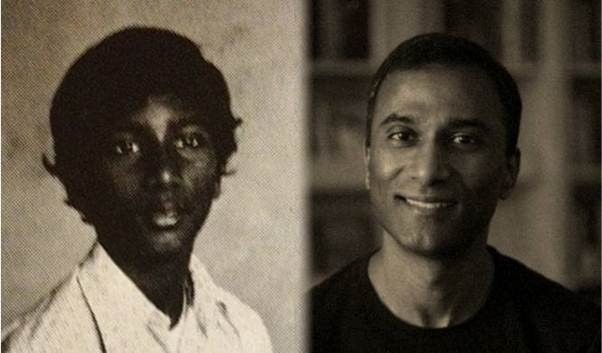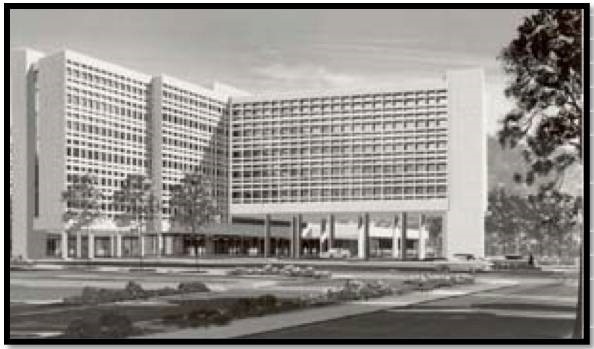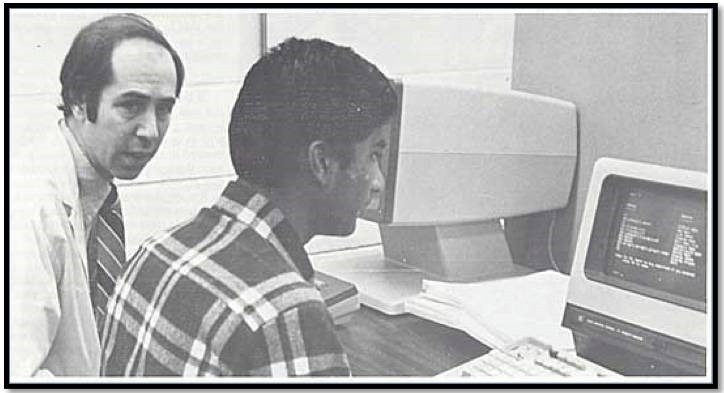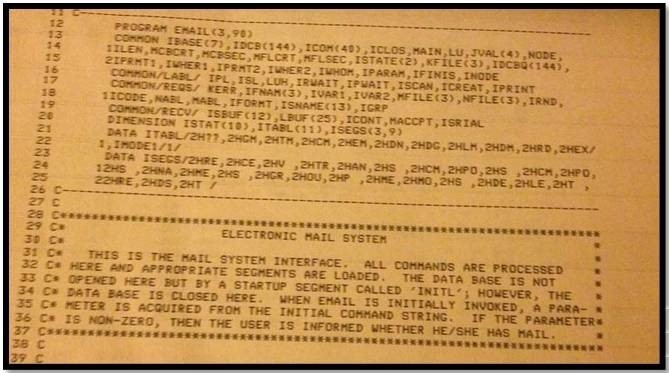The Indian who invented email
Meet Shiva Ayyadurai
By Leslie P. Michelson, Ph.D.
Director of High Performance and Research Computing
Rutgers Medical School
Nearly 35 years have passed since V.A. Shiva Ayyadurai invented email in our Laboratory in 1978. Shiva was a 14-year-old student then, and today he is a 50-year-old accomplished inventor, scientist and entrepreneur, who has continued to innovate many things beyond email, providing thousands of jobs across the world.
In September of 2013, Shiva returned back to our Lab, still located in the same place, at 185 South Orange Avenue, Building C, Room 631 in Newark, New Jersey. It was there, in that Lab, that he conceived, designed and invented email, the email that we all experience today.
When Shiva visited us in September of 2013, it was to announce, along with a representative from the Office of the Mayor of Newark, that he was launching Innovation Corps, a foundation to identify, recognize, mentor and support young people, between the ages to 14-18, who wanted to innovate things, small and large, perhaps creations even bigger than email.
In 1978, we were very fortunate to have had the opportunity to work with Shiva. I was Shiva’s supervisor at the time. Today, we are pleased that the Huffington Post has decided to run a Series on the History of Email to commemorate the August 30th Anniversary of Email.
I’m honored to be part of this Series, and to have the opportunity to share my experience for various reasons.
First, I hope to offer the reader a chance to hear from the proverbial “horse’s mouth” that, “Yes!” a 14-year-old boy, in 1978, did create a computer program that was the first electronic replication of the interoffice mail system (Inbox, Outbox, Folders, Memo, Attachments, Address Book, etc.), which he named “email’, the world’s first email system.
Email, the name of the software program he created, was more than just a simple “program” but a complete system — it was the electronic interoffice, inter-organizational mail system, the first of its kind, an integrated platform that provided all the recognizable elements of the email, we all know and use today.
My second reason for writing this article is to offer an appreciation of the ecosystem and environment, in which the invention of email took place at UMDNJ, particularly in light of the events that occurred immediately following the Smithsonian Institution’s acquisition, on February 16, 2012, of Shiva’s computer code, artifacts and papers.
A vocal minority of industry insiders, who had profited directly and indirectly from falsification of email’s history for many decades, carried on a campaign of character assassination following the Smithsonian news. They even bullied journalists and editors, who shared the facts and wrote favorably about Shiva, in order to protect their economic interests. From my observation, what really incited these individuals was that the invention of email, in Newark, NJ, was shattering false narratives on when, where and by whom, innovation could take place.
My third reason, perhaps the more important one, is to share, what I believe is, a much larger truth – that innovation, even as important as email, can occur anywhere, even by a 14-year-old boy, in Newark, New Jersey, if the right structure and resources are provided.
Let us begin by providing you a background to the University of Medicine and Dentistry of New Jersey (UMDNJ) and our relationship with it.
UMDNJ in 1978
In 1975 the IT department of UMDNJ, then officially known as the College of Medicine and Dentistry of New Jersey, hired me, an experimental high energy physicist from Brookhaven National Laboratories, who had some general scientific computing experience and an interest in using minicomputers, the small computers of the time, to control and acquire data from laboratory experiments.
In 1978, UMDNJ, was a young organization, and prior to its establishment as a university of the Health Sciences in December of 1981, it was (and still is) a free-standing public institution comprising several medical schools, a dental school, school for the health related professions and a graduate school of the biomedical sciences. Absent were the STEM fields (science, technology, engineering and mathematics). Rather, UMDNJ focused exclusively on clinical and basic biomedical research and healthcare. Having been signed into law in 1970 and comprised of the former Rutgers Medical School and the New Jersey College of Medicine and Dentistry, UMDNJ was establishing itself as a major academic health sciences institution.
The IT department at the time, although small, included a scientific data processing group. The group was populated with several biostatisticians and mainframe computer experts. The staff interacted with faculty from numerous departments both in the clinical and basic sciences and became quite adept at introducing machine computation to life scientists, who, given their backgrounds and given the time period had little experience in using computers. Our main local computing device, an IBM remote job entry terminal, was connected to remote batch and time sharing machines operated by an educational consortium known as the New Jersey Educational Computer Network.
Minicomputers made by Digital Equipment Corporation, Data General, Hewlett Packard and others were in fairly widespread use by 1975. They were used with growing frequency in disciplines ranging from nuclear physics to neuroscience. Medical equipment manufacturers were beginning to incorporate them as control and analysis elements in a new device called CAT Scan and they would soon give rise to a new generation of diagnostic instrumentation in which the rate of data acquisition and manipulation mandated the use compact computing hardware built into or adjacent to the instrument.
UMDNJ in 1978.
We were connecting minicomputers directly to laboratory equipment to automate data collection and effect control systems in which real time analysis could influence the generation of electrical stimulus thereby helping to guide the progress of neurophysiological lab experiments. Other life sciences disciplines were similarly suited to this kind of automation.
Although vastly less costly than mainframes, minicomputers were not inexpensive. Furthermore, we had several campuses on which to distribute the minicomputer resources including Newark, Piscataway and New Brunswick. These challenges led to the development of a network we called the LCN for Laboratory Computer Network, where more capable minicomputers were connected to one another and to smaller laboratory machines we called satellite nodes. The satellite nodes, more often than not, lacked a mass storage device — they were very expensive at the time — and depended on the larger nodes to boot their operating systems and applications.
Creating Ecosystem for Innovation
Today, there is a lot of effort underway to create innovation hubs or innovation centers. Our group at UMDNJ, far more modest in retrospect, provided an emerging ecosystem and environment for such innovation. We had the basic infrastructure, and above all were able to attract smart and dedicated people, curious and passionate, who wanted to explore new platforms. Though we ran the scientific data processing organization at UMDNJ, in a medical college in the late 1970s, it was frankly an unusual place to find the kind of experimentation that would lead to automation advances such as email that would change the way an important human-to-human communication paradigm would be mediated.
Our computer hardware infrastructure at the time comprised mainframes, minicomputers and microcomputers. The microcomputer, while an exciting and clearly promising architecture, was mainly seen in industrial controllers and as a part of larger computer components. The microcomputer had also become an obsession for many computer hobbyists. The IBM PC and subsequent wide spread adoption of desktop computing was still a few years away. Standardized networks as envisioned by the National Science Foundation’s NSFnet and its commercial successor, the Internet, were almost a decade away.
The predominant use of computers at the time was administrative business processing, scientific calculation and machine-aided design for engineering problems. However, while the role of computation in the broader context of human endeavor would lie in the distance, our hope was to explore such areas. So, we were open to finding others who wanted to participate in such exploration.
We had resources, space, a network and computing power.
Our team included the late Phil Goldstein who was an early innovator in the educational use of time-sharing systems; Robert Field, a database programmer; and Marilyn Bodow and Tina Brezenoff, statistical programmers in our group, who were looking to provide better interfaces for broader use of statistics packages. Dave Ritacco, a wunderkind studying engineering at the Stevens Technical Institute, also began working with us to develop user interfaces for graphics systems, predecessor to modern day presentation graphics.
It was in this environment that we met Shiva.
The Creation of Email
In 1978, a colleague, Martin Feuerman, from our parent IT organization approached us to ask if we would spend some time with Shiva, a 14-year-old high school student from Livingston New Jersey. Meenakshi Ayyadurai, Shiva’s mother, told me that her son had just completed a special program in computer programming at the Courant Institute of Mathematical Sciences at New York University (NYU) for young persons who had demonstrated significant promise in mathematics. Our willingness to talk to Shiva, unfolded into an exciting diversion from the major focus of our work.
Leslie P. Michelson (left) and V.A. Shiva Ayyadurai (right).
By the time Shiva joined the LCN as a high school Research Scholar, a few of us were beginning to ponder the role minicomputers might play in the larger space of human interaction. We were obviously familiar with the nature of the simple interactivity between humans and machines — after all, much of the software we developed to manage lab experiments required interactivity if an investigator was to be in the loop of experimental input and resultant response. We were also familiar with the methods and protocols by which computers could exchange messages with other similar types of computers. Our minicomputers, manufactured by the Hewlett Packard Corporation, were provisioned with subsystems that supported this type of communication. Human interaction was mediated through teletypewriters and relatively primitive CRT-based display devices.
The age-honored interoffice memorandum, the “memo”, the primary modality of written human-human communication in the workplace was widely used at UMDNJ as it was everywhere else. The memo, regardless of the method of transport and retrieval has the general properties of one-to-one or one-to-many distribution and is easily filed to keep a record of a particular human discourse. In 1978, as in decades earlier, the memorandum was delivered by hand or in the case of a campus or group of campuses, placed in a mailer and transported by an interoffice/inter-organizational/campus/intercampus paper mail process, that including pneumatic tubes.
It did not take long to recognize that Shiva was an exceptional student and to determine that we could challenge him in extraordinary ways. Although beyond the scope of our responsibility, we were eager to explore the use of small computers outside of the space of numerical calculation and experiment control. The notion of automating the entire interoffice, inter-organizational paper mail process to create a system was appealing for several reasons: It was a ubiquitous process, the mechanics of which, at least superficially, could be understood by anyone; the advantage of automation was obvious in that it would be possible to significantly collapse the time frame of transactions; and there were multiple ways in which electronic automation could extend the utility of the memorandum.
As far as we knew, no one else in 1978 had attempted to take on such a task.
In fact, recently, we discovered historical documents, including the famous RAND report written by David Crocker, which clearly stated that ARPANET researchers thought it “impossible” and did not even “attempt” to take on such a task. In the December 1977, RAND report, Mr. Crocker stated:
“At this time, no attempt is being made to emulate a full-scale, inter-organizational mail system. The fact that the system is intended for use in various organizational contexts and by users of differing expertise makes it almost impossible to build a system which responds to all users’ needs.” (Crocker, D., December of 1977)
The reader should be aware, that after the Smithsonian’s acceptance, on February of 2012, of Shiva’s papers documenting his invention at UMDNJ, it was Mr. Crocker, who led a vitriolic campaign across the Internet to brush aside and diminish the invention of email by Shiva at UMDNJ. For decades, Mr. Crocker and his ARPANET fraternity had conflated their contributions to email by crediting themselves as “inventors of email” by misusing the term “email” to refer to their work in Text Messaging as “email”. As the historical RAND report clearly shows, neither Mr. Crocker nor his colleagues at the ARPANET, per his own admission, had any intention to create email, the inter-organizational mail system.
When Mr. Crocker’s RAND Report was found by MIT student researcher Devon Sparks, and released on the web site www.inventorofemail.com, Mr. Crocker, who I had no relationship with, contacted me and requested to meet me behind closed doors, likely to perform damage control as his contradictory behavior was being exposed.
I declined Mr. Crocker’s request.
The damage he and his ARPANET fraternity had done by being accomplices to the defamatory journalism, unleashed on Shiva, was beyond inexcusable. We hope that on the Anniversary of Email, Mr. Crocker reads his December 1977 RAND Report, and issues a public apology to Shiva, if he desires an authentic intellectual exchange with Shiva and me.
So, for us in 1978, the creation of an electronic version of the interoffice, inter-organizational paper mail process became the object of our affection. This was a different perspective than Mr. Crocker and the ARPANET researchers, who chose not to attempt to emulate a full-scale inter-organizational mail system, and had deemed the creation of such a system impossible.
We were confident that Shiva could do it.
We sat Shiva down and offered him what turned out to be one of most innovative (and fun) projects our group was ever to undertake. In return, we demanded that this 14-year-old youngster channel all of his energies into the project. We made it very clear that he would be a full-fledged member of our team, treated as an adult and that we would expect nothing less from him. Livingston High School agreed to Shiva spending initially a few days a week and later to half-days at the Newark, New Jersey Campus.
Shiva was eager to begin writing code — after all that was the most fun. It was surprisingly easy, though, to convince Shiva that the code would just be a physical embodiment of the design. Although, we would need a working version, indeed a production model, the lasting contribution would be the systems analysis that we hoped would lead to implementation that was more than the mere automation of a manual process. We wanted to develop a sustainable logical and functional framework that would add significant value and lead to further innovation over time.
Shiva’s first task was to learn how the interoffice memorandum was used at the University. Who wrote them and to whom? What was their place in the hierarchy of written documentation? What was the sender’s expectation of a reply? What volume could we anticipate? And, of course, what could we do to improve the utility of this modality? Surely, user would want more features as soon as they recognized this new potential. Could we be one step ahead?
Thus, after long deliberations, always with Shiva in the lead, we arrived at core design principles, which in the context of the day, were original, and forward looking at the very least:
o A simple user interface would require no specific computer knowledge and would provide access to all program features at the user level. Command lines are to be prohibited — our users were life science researchers, clinicians and administrators, not computer scientists.
o The user interface would include a visual compose mode with spelling and formatting capability.
o Interoffice memos would be stored in a structure database and replicated on each node, which would also manage account and routing information.
o Only one instance of a message would exist on any one node until the last recipient elected to delete it or save it in another location.
o Each instance of the program would operate independently of the status of other nodes or the University’s local- and wide-area networks (such as they existed at the time).
o Delivery would be guaranteed.
o Attributes, considered to be part of a letter-based postal delivery system, such as return receipt requested would be implemented.
o A full management interface with account maintenance, environment status and debugging tools would be developed.
o The electronic metaphor of all the other elements of the interoffice, inter-organizational paper mail system would need to be incorporated: inbox, outbox, folders, memo structure, address book and other important features, that we now have in modern email systems.
Our software tools were relatively primitive. A FORTRAN IV compiler with restrictive variable naming conventions and lacking intrinsic file system access; a non-relational, hierarchical database management system; and a simple networking environment that permitted static routing among nodes in a predetermined mesh. These tools ran on the HP1000 platform, a real-time environment not particularly optimal for the kind of development we envisioned.
Innovation Anywhere, Anytime by Anyone
These impediments turned out to be of little consequence, but certainly upped the complexity of the programmer’s task and by some measure, Shiva’s accomplishment. In fact, the inflexibility of the development and execution environment turned out to be somewhat serendipitous.
First page of the computer program showing Shiva’s naming the program “email,” thus defining email to be the electronic interoffice mail system.
Our project combined the attributes of both the interoffice memorandum and paper mail systems. The FORTRAN IV compiler limited variable names to six characters. Moreover, the RTE/IVB operating system running on our HP1000 computers limited process names to five characters.
Did I hear EMAIL?
Of course! Our new service was electronic and it combined many if not all of the characteristics of paper mail. I can attest that Shiva was the sole author of the entire EMAIL program and system.
A few years later, Shiva, obtained a Copyright for the program. Nearly 500 users used the system. The rest should be history.
Official US Copyright Notice for “Email” Issued on August 30, 1982, now, in the Smithsonian Institution National Museum of American History (NMAH).
Shiva had written some 50,000 lines of FORTRAN code across more than a dozen cooperating processes that communicated within a node and across the Laboratory Computer Network. In those days, the total amount of memory to run the program on the computer was less than 64 Kilobytes! Shiva had to find clever ways to unload and load those processes, in a seamless manner. This was not easy, and required a great deal creativity, persistence and determination.
We recall that on formal launch day, we filled a large lecture hall at the New Jersey Medical School with technical staff and other parties that were fascinated by the work Shiva had done. Here we were, all of these people: IT professionals, administrators, family and friends to learn what Shiva had done. Multiple screens and white boards filled with charts, “screen shots” and flow diagrams kept everyone’s attention. There was a bizarre aspect that pervaded all of this.
The presenter was not a distinguished scientist or clinician from UMDNJ or some other vaunted institution, but rather a very young man, a teenager, with a fascinating story of ingenuity and determination.
There is much credit to spread around the vast community of academic, industrial and military researchers and engineers who eclipsed the industrial revolution with their contributions to computer science and computer and network engineering.
We take no credit where it is not due.
We will, however, stand firmly for the innovation that took place at a health sciences institution, an unlikely venue for the work we did. Our incentive was not fame nor fortune, but rather a challenge that arose from our own experiences and our desire to take on a challenge and place our faith on the resources of a 14-year-old student from Livingston, New Jersey, who was disciplined and found a way to come to Newark, NJ to work.
There is a larger story here, one that should be evident by now.
Innovation can happen anywhere, anytime by anyone. The sooner we embrace this truth, the sooner our lives will be enriched by the thousands of other “Shivas” that do not have the luxury of working in the established bastions of innovation, but nevertheless have the intellect and drive to make big contributions.
____________
Leslie P. Michelson, Ph.D. is the Director of High Performance and Research Computing Division, Rutgers Medical School (RMS). In 1975, the University of Medicine and Dentistry of New Jersey (UMDNJ), now a part of RMS, recruited Dr. Michelson, a trained theoretical physicist from Brookhaven National Laboratories. His group at RMS develops solutions in the life sciences for research endeavors with demanding computational requirements. In the late 1970’s Michelson’s organization provided the challenge, resources and mentorship that led to the development of the first electronic interoffice memorandum postal system by V.A. Shiva Ayyadurai. Throughout his career Michelson has been active in the support of the use of networking technologies to advance research and education interests in the State of New Jersey. He was a founder and served as the third president of the New Jersey Intercampus Network, the predecessor of the State’s Higher Education and Research Network, NJEDge.Net.







Comments